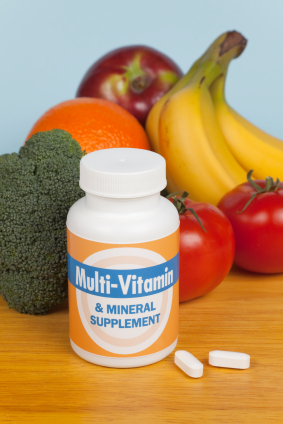Vitamin B3 (niacin) Information
The Benefits of Vitamin B3 (niacin)
By: Dr. George Obikoya
Vitamin B3 is a water-soluble vitamin vital for energy release in tissues and cells. It belongs to the B complex group of vitamins. It is also called the pellagra-preventive vitamin, or vitamin PP, because an adequate amount in the diet prevents pellagra, a chronic disease characterized by skin lesions, gastrointestinal disturbance, and nervous symptoms.
Niacin, aka Vitamin B3, comes in two basic interchangeable forms--niacin (also called nicotinic acid) and niacinamide (also called nicotinamide). A variation on niacin, called inositol hexaniacinate, is also available in supplements. Some doctors recommend inositol hexaniacinate for people who need large amounts of niacin because it has not been linked with any of the usual niacin toxicity in scientific research.
Like vitamin Like vitamin B1 (thiamine) and vitamin B2 (riboflavin), it is a coenzyme involved in the metabolism of carbohydrates and acts to catalyze the oxidation of sugar derivatives and other substances.
Niacin, which was identified as a pellagra preventive in 1937. We need about 10 to 20 milligrams per day (1 milligram = 0.001 gram) of nicotinic acid. In the intestinal tract, the amino acid tryptophan can be converted to niacin by bacterial action and thus can serve as a source for part of the niacin we need. This explains scientists' early observation that the protein in such foods as eggs and milk, both poor sources of niacin, can nevertheless prevent or cure pellagra in humans.
Niacin is one of the most stable vitamins. It helps form NAD (nicotinamide adenine dinucleotide) and NADP (nicotinamide adenine dinucleotide phosphate), coenzymes which are involved in the release of energy and food. These compounds help to maintain a healthy nervous and digestive system. Vitamin B3 is essential for normal growth and for healthy skin.
Vitamin B3 is required for the proper function of more than 50 enzymes. Without it, your body would not be able to release energy or make fats from carbohydrates. Vitamin B3 is also used to make sex hormones and other important chemical signal molecules.
A deficiency of niacin causes pellagra, the first symptom of which is a sunburn-like eruption that breaks out where the skin is exposed to sunlight. Later symptoms are a red and swollen tongue, diarrhea, mental confusion, irritability, and, when the central nervous system is affected, depression and mental disturbances.
The body makes niacin from the amino acid tryptophan. Megadoses of niacin have been used to treat schizophrenia. In large amounts, sometimes more than 1,000 milligrams a day, niacin has been shown to reduce LDL cholesterol (the 'bad' cholesterol that clogs the heart's arteries) and triglycerides and raise HDL cholesterol (the 'good' cholesterol that prevents hardening of the artery walls)1. Niacin has been used extensively in preventing and treating arteriosclerosis. Additionally, good evidence suggests that a special form of niacin, inositol hexaniacinate, can improve walking distance in intermittent claudication. It may also reduce symptoms of Raynaud's phenomenon.
High-dose niacinamide is helpful in preventing type 1 (childhood-onset) diabetes2 and reducing symptoms of osteoarthritis3 However, you should only take increased doses of niacin under the supervision of a physician as too large doses over long periods may cause liver damage.
Women should have 15 milligrams each day and men should have 15
to 19 milligrams each day. Tryptophan is an amino acid that serves
as a Vitamin B3 equivalent. Sixty milligrams of tryptophan is equal
to 1 milligram of vitamin B3.
Doses of over 150mg of the nicotinic acid form may cause temporary
flushing of the skin in some people. Upper safe level: nicotinamide
- 450mg (long term usage); 1500 mg (short term usage). Nicotinic
acid - 150mg (long term usage); 500mg (short term usage)
The antituberculosis drug isoniazid (INH) impairs the conversion of tryptophan to niacin, and may produce symptoms of niacin deficiency.
When used as therapy for a specific disease, niacin, niacinamide, and inositol hexaniacinate are taken in dosages much higher than nutritional needs, about 1 to 4 g daily. Because of the risk of liver inflammation at these doses, medical supervision is essential.
For prevention of diabetes in children, the usual dosage of niacinamide is 25 mg per kilogram body weight per day. There are 2.2 pounds in a kilogram, so a 40-pound child would get about 450 mg daily. Medical supervision is essential before giving your child long-term niacinamide treatment.
Many people experience an unpleasant flushing sensation and headache when they take niacin. These symptoms can usually be reduced by gradually increasing the dosage over several weeks or by using slow-release niacin. However, slow-release niacin appears to be more likely to cause liver inflammation than other forms. Inositol hexaniacinate may also cause less flushing than plain niacin, and if you take an aspirin along with niacin, the flushing reaction will usually decrease.
A good multivitamin is the foundation of health and nutrition. Take a look at our scientific reviews of many of the popular brands for factors such as ingredients, areas of improvement, quality level, and overall value. If you are looking for a high quality liquid multivitamin, we suggest that you take a look at the Multivitamin Product Comparisons.
References
1. Guyton JR, Goldberg AC, Kreisberg RA, et al. Effectiveness of
once-nightly dosing of extended-release niacin alone and in combination
for hypercholesterolemia. Am J Cardiol 82: 737-743, 1998.
2. Elliott RB, Pilcher CC, Fergusson DM, et al. A population based strategy to prevent insulin-dependent diabetes using nicotinamide. J Pediatr Endocrinol Metab 9: 501-509, 1996.
3. Jonas WB, Rapoza CP, and Blair WF. The effect of niacinamide on osteoarthritis: a pilot study. Inflamm Res 45: 330-334, 1996.

